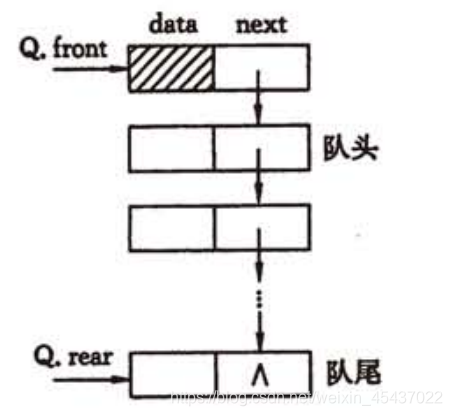队列
队列(queue)是一种先进先出(first in first out)的线性表。
它只允许在一端进行插入,而在另一端进行删除元素
允许插入的一端叫做队尾(rear),允许删除的一端叫做对头(front)
队列的实现有两种:①顺序队列 ②链式队列
例如:我们在排队时,就可以看做一个队列
队列示意图

顺序队列
一、概念
顺序队列存储数据采用的是动态分配的一块额定的空间
二、图解

三、参考源码
头文件
#include <stdio.h>
#include <stdlib.h>
#include <assert.h>
#include <stdbool.h>
顺序队列结构定义
//定义常量
#define DEFAULT_QUEUE_CAPACITY 8
#define DEFAULT_CAPACITY_GROW_MULTIPLE 2
typedef int ET;
//顺序队列
typedef struct SeqQueue
{
ET *base; //存储空间
size_t capacity; //当前最大容量
size_t head; //头结点索引
size_t tail; //尾节点索引
}SeqQueue;
方法声明
void SeqQueueInitial(SeqQueue *psq, size_t cap); //初始化顺序队列
bool IsEmpty(SeqQueue *psq); //判断队列是否为空
bool IsFull(SeqQueue *psq); //判断队列是否为满
void CapacityGrow(SeqQueue *psq); //队列扩容
void SeqQueueIn(SeqQueue *psq, ET x); //入队
void SeqQueueOut(SeqQueue *psq); //出队
ET SeqQueueGetHead(SeqQueue *psq); //获取头元素
ET SeqQueueGetTail(SeqQueue *psq); //获取尾元素
size_t SeqQueueGetLength(SeqQueue *psq); //获取当前队列长度
void SeqQueueShowData(SeqQueue *psq); //展示队列中的数据
void SeqQueueDestroy(SeqQueue *psq); //摧毁队列结构
方法定义
void SeqQueueInitial(SeqQueue *psq, size_t cap){
assert(psq != NULL);
psq->capacity = cap > DEFAULT_QUEUE_CAPACITY ? cap : DEFAULT_QUEUE_CAPACITY;
psq->head = psq->tail = 0;
psq->base = (ET*)malloc(sizeof(ET)* psq->capacity);
}
bool IsEmpty(SeqQueue *psq){
assert(psq != NULL);
if (psq->tail == 0){
return true;
}
return false;
}
bool IsFull(SeqQueue *psq){
assert(psq != NULL);
if (psq->tail == psq->capacity){
return true;
}
return false;
}
void CapacityGrow(SeqQueue *psq){
assert(psq != NULL);
psq->capacity *= DEFAULT_CAPACITY_GROW_MULTIPLE;
ET* new_base = (ET*)realloc(psq->base, psq->capacity);
psq->base = new_base;
}
void SeqQueueIn(SeqQueue *psq, ET x){
assert(psq != NULL);
if (IsFull(psq)){
CapacityGrow(psq);
}
psq->base[psq->tail++] = x;
}
void SeqQueueOut(SeqQueue *psq){
assert(psq != NULL);
if (psq->tail == psq->head){
//空队列
return;
}
else{
if (psq->tail == 1){
psq->tail--;
}
else{
int i = psq->head;
for (; i < psq->tail - 1; i++){
psq->base[i] = psq->base[i + 1];
}
psq->tail--;
}
}
}
ET SeqQueueGetHead(SeqQueue *psq){
assert(psq != NULL);
if (IsEmpty(psq)){
return;
}
return psq->base[psq->head];
}
ET SeqQueueGetTail(SeqQueue *psq){
assert(psq != NULL);
if (IsEmpty(psq)){
return;
}
return psq->base[psq->tail - 1];
}
size_t SeqQueueGetLength(SeqQueue *psq){
assert(psq != NULL);
return psq->tail;
}
void SeqQueueShowData(SeqQueue *psq){
assert(psq != NULL);
int i = psq->head;
printf("Head <- ");
for (; i < psq->tail; i++){
printf("%d <- ", psq->base[i]);
}
printf("Tail.\n");
}
void SeqQueueDestroy(SeqQueue *psq){
assert(psq != NULL);
psq->head = psq->tail = psq->capacity = 0;
free(psq->base);
psq = NULL;
}
链式队列
一、概念
链式队列中存储数据是用动态分配的结点来存储的,这个结点由两部分组成:数据域和指针域,通过指针将结点与结点之间相连
二、图解

三、参考源码
头文件
#include <stdio.h>
#include <stdlib.h>
#include <assert.h>
#include <stdbool.h>
链式队列结构定义
//定义常量
typedef int ET;
//链队列
typedef struct Node
{
ET data;
Node* next;
}Node;
typedef struct LinkedQueue
{
Node* head;
Node* tail;
}LinkedQueue;
方法声明
Node* CreateNode(ET val); //创建并返回一个结点
bool IsEmpty(LinkedQueue *pq); //判断队列是否为空
void LinkedQueueInit(LinkedQueue *pq); //初始化队列
void LinkedQueueIn(LinkedQueue *pq, ET val); //入队
void LinkedQueueOut(LinkedQueue *pq); //出队
ET LinkedQueueGetFront(LinkedQueue *pq); //获取头结点
int LinkedQueueSize(LinkedQueue *pq); //获取队列长度
void LinkedQueueShow(LinkedQueue *pq); //展示队列中的数据
void LinkedQueueDestroy(LinkedQueue *pq); //摧毁队列结构
方法实现
Node* CreateNode(ET val){
Node* s = (Node*)malloc(sizeof(Node));
assert(s != NULL);
s->data = val;
s->next = NULL;
return s;
}
bool IsEmpty(LinkedQueue *pq){
assert(pq != NULL);
return pq->head == NULL;
}
void LinkedQueueInit(LinkedQueue *pq){
assert(pq != NULL);
pq->head = pq->tail = NULL;
}
void LinkedQueueIn(LinkedQueue *pq, ET val){
assert(pq != NULL);
Node* s = CreateNode(val);
if (pq->head == NULL){
//空队列
pq->head = pq->tail = s;
}
else{
//队列非空
pq->tail->next = s;
pq->tail = s;
}
}
void LinkedQueueOut(LinkedQueue *pq){
assert(pq != NULL);
Node* s = pq->head;
if (pq->head == NULL){
//空队列
return;
}
else{
//队列非空
if (pq->head->next == pq->tail){
//只有一个元素
pq->head = pq->tail = NULL;
free(s);
}
else{
//多个元素
pq->head = s->next;
free(s);
}
}
}
ET LinkedQueueGetFront(LinkedQueue *pq){
assert(pq != NULL);
if (pq->head == NULL) //空队列
return -1;
return pq->tail->data;
}
int LinkedQueueSize(LinkedQueue *pq){
assert(pq != NULL);
size_t len = 0;
if (pq->head == NULL){
return len;
}
else{
Node* p = pq->head;
while (p != NULL){
p = p->next;
len++;
}
}
return len;
}
void LinkedQueueShow(LinkedQueue *pq){
assert(pq != NULL);
Node* p = pq->head;
printf("Head->");
while (p != NULL){
printf("%d->", p->data);
p = p->next;
}
printf("Tail.\n");
}
void LinkedQueueDestroy(LinkedQueue *pq){
assert(pq != NULL);
if (pq->head == NULL){
return;
}
else{
Node* p = pq->head;
Node* q = pq->head;
while (q != NULL){
q = q->next;
free(p);
p = q;
}
pq->head = pq->tail = NULL;
}
}